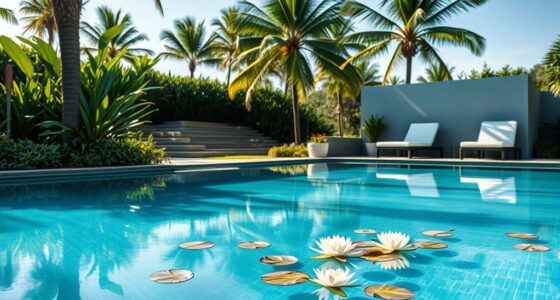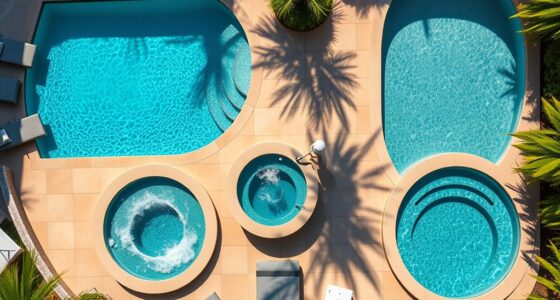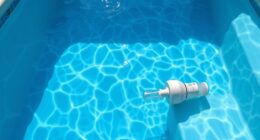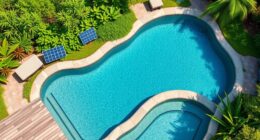To maximize warmth, face your pool toward the sun’s course, ideally south or southeast if you’re in the northern hemisphere. Position it where sunlight hits it longer, especially during winter, and use natural windbreaks like trees or fences to cut down on cooling and evaporation. Slightly tilting the pool orientation can boost solar gain further. Keep exploring to discover more ways to optimize your pool’s placement for comfort and energy savings.
Key Takeaways
- Orient the pool to face south or southeast to maximize sunlight exposure throughout the day.
- Position the pool in a sheltered area away from prevailing winds to reduce cooling and evaporation.
- Use natural barriers like trees or fences to block wind and enhance solar heat retention.
- Slightly tilting the pool or adjusting its orientation can improve solar gain, especially during low sun angles.
- Consider landscape features and climate to select an optimal location that balances sun exposure and wind protection.
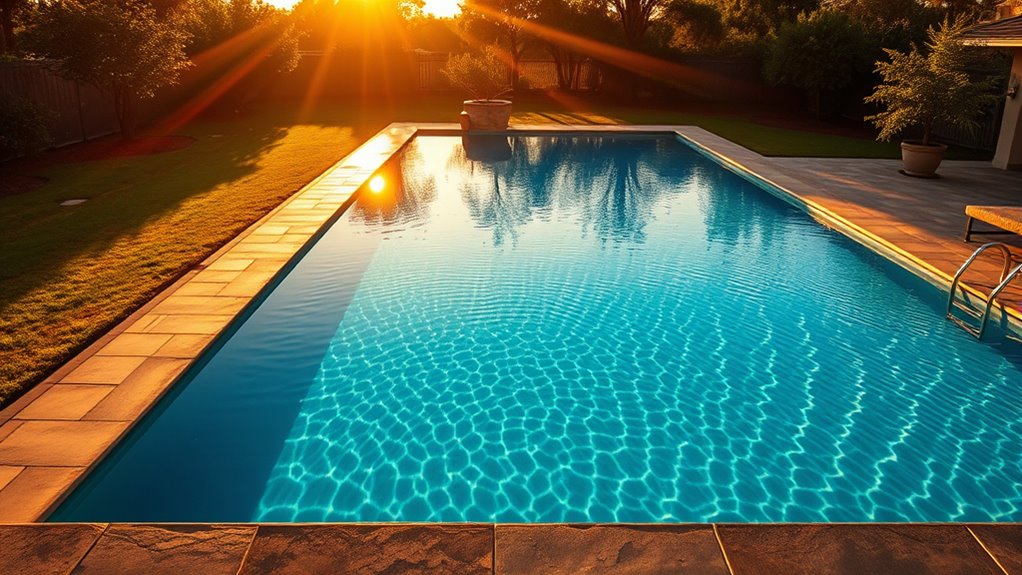
Choosing the right pool orientation can considerably enhance your outdoor experience by maximizing sunlight exposure and reducing energy costs. When you position your pool thoughtfully, you tap into natural heat sources like solar gain, making your swimming season longer and more enjoyable. Proper orientation also helps mitigate wind exposure, which can cool the water and increase evaporation, leading to higher heating and water replacement costs. By aligning your pool to the sun’s path, you ensure it receives the maximum amount of direct sunlight throughout the day, boosting warmth and comfort without additional energy input.
Maximize sunlight and reduce costs by strategically orienting your pool for optimal solar gain and wind protection.
To optimize solar gain, face your pool toward the sun’s path—ideally, south or southeast in the northern hemisphere. This positioning allows sunlight to hit the water for longer periods, warming it naturally. During winter, this effect is even more noticeable, helping you keep the water comfortable without relying heavily on heaters. As the sun moves across the sky, a well-oriented pool maintains consistent warmth, making it more inviting for longer periods. Keep in mind that a slight tilt in the pool’s orientation can improve solar gain further, especially if you’re in an area with a lower sun angle during winter months. Additionally, considering temperature fluctuations and local climate can help you plan the best orientation for year-round comfort.
Wind exposure is another critical factor in pool placement. If your property experiences strong prevailing winds, placing your pool in a sheltered spot reduces heat loss due to wind chill and minimizes water evaporation. A windbreak, such as trees, fences, or shrubs, can serve as a buffer, shielding the water surface from gusts that sap heat and cause splashing. Without proper protection, wind can substantially cool the water, forcing you to run your heater more often and increasing operational costs. Accordingly, choosing a location that naturally blocks prevailing winds or installing barriers can make a big difference in maintaining water temperature and conserving energy.
Additionally, consider your local environment and landscape when planning your pool’s orientation. Avoid placing it in shaded or overly windy areas, but also be mindful of preserving privacy and aesthetics. By balancing these factors, you create a comfortable, energy-efficient outdoor oasis. Remember, small adjustments in orientation can lead to noticeable improvements in warmth and cost savings. With a strategic approach to solar gain and wind exposure, you’ll enjoy a warmer, more inviting pool that maximizes your outdoor space’s potential while keeping energy bills in check.
Frequently Asked Questions
How Does Wind Affect Pool Temperature and Comfort?
Wind can lower your pool temperature and reduce comfort by increasing wind chill, making the water feel colder. It also impacts air circulation around the pool, which can lead to faster heat loss. To keep your water warm and enjoyable, consider installing windbreaks like screens or fences. These help block the wind, maintain warmer air temperatures, and improve overall comfort while swimming.
Can Shading Devices Improve Pool Warmth During Winter?
Shading devices can markedly boost pool warmth in winter, acting like cozy blankets for your water. Installing solar covers or insulating blankets traps heat, preventing it from escaping into the cold air—think of wrapping your pool in a warm, protective hug. These devices maximize sun energy and keep the warmth in, making your pool inviting even when winter’s chill tries to steal the heat.
What Is the Best Pool Orientation for Year-Round Sun Exposure?
You should orient your pool east-to-west to maximize year-round sun exposure, especially in winter. This setup allows the sun to warm the water effectively while minimizing shade from nearby structures. Incorporate pool shade strategically to prevent excessive heat loss and guarantee proper water circulation for even temperature distribution. With this orientation, you’ll enjoy warmer, more inviting water throughout the year, regardless of seasonal changes.
How Do Surrounding Trees Influence Pool Temperature and Maintenance?
Surrounding trees can lower your pool’s temperature by providing tree shade, which blocks sunlight that naturally warms the water. However, foliage loss causes leaves and debris to fall into your pool, increasing maintenance efforts. You’ll need to regularly skim and clean to prevent clogging and algae growth. Consider trimming overhanging branches or choosing trees that shed less foliage to balance shade benefits with easier upkeep.
Are There Specific Materials That Retain Heat Better in Pools?
You should consider insulation options like foam boards or pool covers to retain heat effectively. Thermal blankets are especially useful, as they minimize heat loss when the pool isn’t in use. These materials work together to keep your water warm longer, reducing energy costs. Using insulation and thermal blankets regularly helps maintain a comfortable temperature, so you enjoy your pool even in cooler weather.
Conclusion
By understanding the sun’s path and choosing the right pool orientation, you can make the most of the natural warmth and sunlight. It’s all about working smarter, not harder, to enjoy a cozy, inviting pool with less energy. When you align your pool thoughtfully, you’re hitting two birds with one stone — maximizing warmth and minimizing energy costs. So, take the time to plan wisely, and your pool will be a warm haven all season long.




